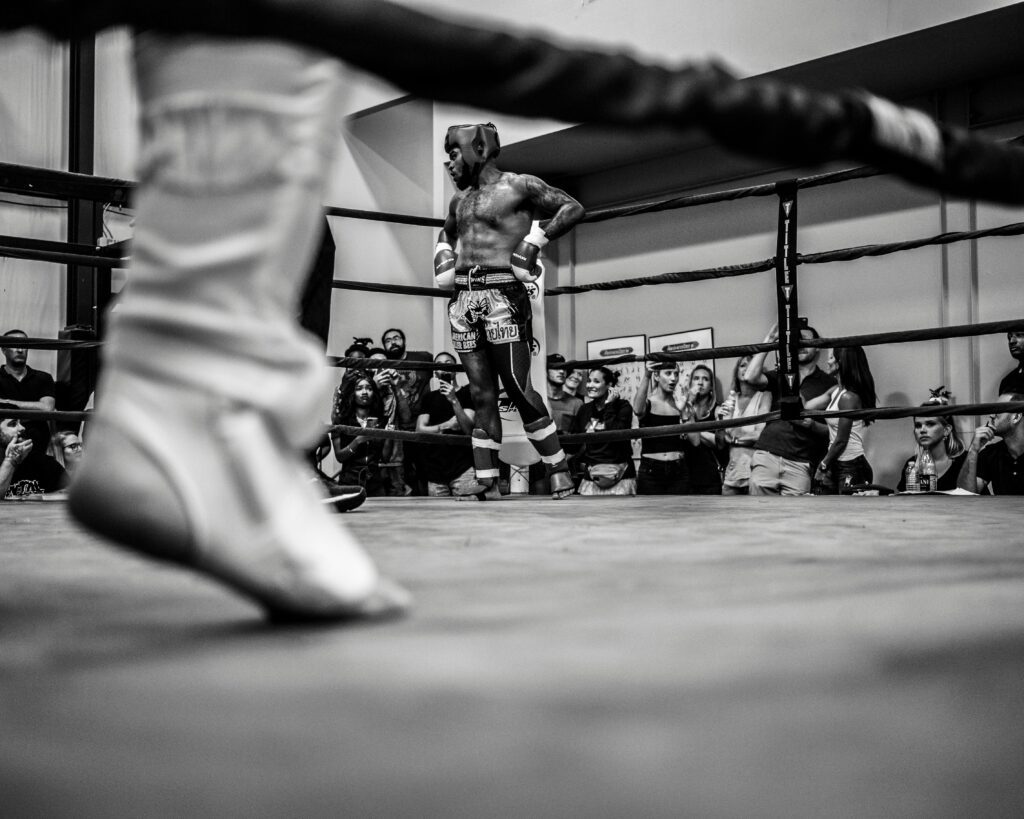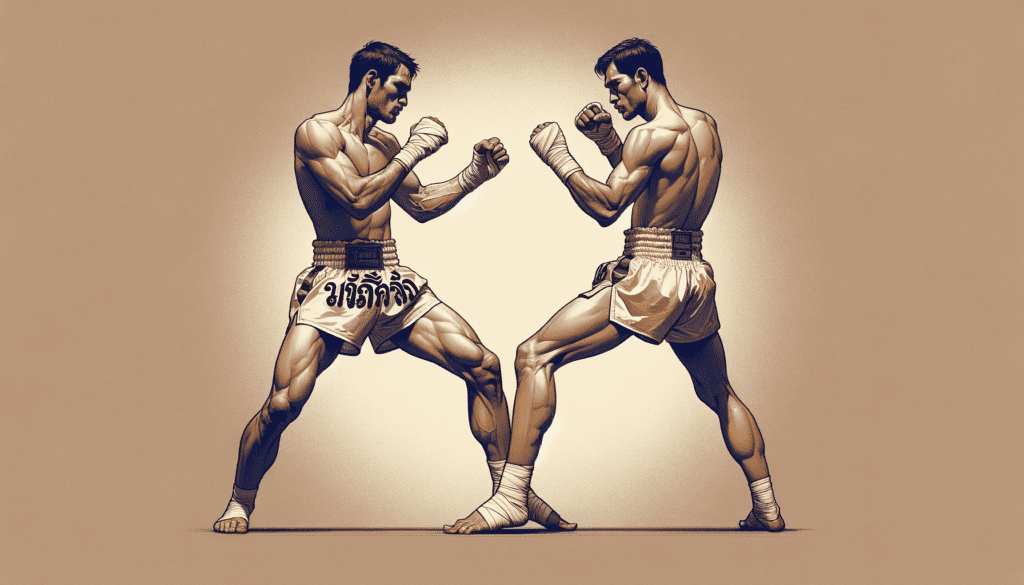Muay Thai, born in the battlefields of ancient Siam (modern-day Thailand), has evolved into one of the most respected and feared striking arts in the world. Its effectiveness isn’t just folklore – it’s been demonstrated time and again in mixed martial arts competitions and, unfortunately, in real-life altercations.
A notable example occurred in 2019, when a Muay Thai practitioner in Phuket successfully defended himself against two attackers outside a nightclub. Using swift elbow strikes and powerful knee thrusts, he neutralized the threat in seconds, showcasing the art’s efficiency in chaotic, real-world scenarios.
However, no martial art is invincible, and Muay Thai is no exception. Its effectiveness in street fights depends on various factors: the practitioner’s skill level, the specific situation, and even luck. What Muay Thai does offer is a comprehensive striking system that prepares practitioners for the unpredictability of street encounters.
The following sections will explore how Muay Thai compares to other popular martial arts in street fight scenarios, examining its strengths, acknowledging its limitations, and explaining why many consider it one of the most effective martial arts for self-defense.
Boxing vs. Muay Thai in a Street Fight
Boxing and Muay Thai are both renowned for their striking power, but they bring different skills to the table. Boxing focuses on punches, footwork, and head movement, making it incredibly effective at close range. However, Muay Thai takes a more comprehensive approach. Known as the “Art of Eight Limbs,” Muay Thai utilizes fists, elbows, knees, and shins, offering a broader arsenal for self-defense. In a street fight, where unpredictability is the norm, the versatility of Muay Thai can provide a significant edge.

Comparing Muay Thai to Other Popular Martial Arts
Karate, Brazilian Jiu-Jitsu, Taekwondo – each has its strengths. Karate emphasizes powerful strikes and disciplined movement, BJJ focuses on ground control and submissions, and Taekwondo is famed for its high, fast kicks. Muay Thai’s distinction lies in its real-world applicability. It’s designed to deliver maximum impact with minimal effort, making it a formidable choice in the chaos of a street confrontation.
What Martial Art is Most Effective in a Street Fight?
Determining the most effective martial art for street fights is a complex task, as real-world confrontations differ significantly from controlled sporting environments. While Muay Thai has proven its worth, other martial arts also offer valuable skills for self-defense.
Krav Maga, developed by the Israeli military, is renowned for its focus on real-world scenarios and quick neutralization of threats. Its no-holds-barred approach and emphasis on situational awareness make it highly effective in unpredictable street encounters.
Brazilian Jiu-Jitsu (BJJ) excels in ground combat, a common element in street fights. Its techniques allow smaller individuals to effectively defend against larger attackers, particularly in one-on-one situations.
Boxing, with its focus on quick footwork and powerful punches, can be devastatingly effective in close-quarters combat. The ability to throw rapid combinations and move efficiently makes boxers formidable opponents in stand-up confrontations.
Mixed Martial Arts (MMA) training, which combines elements from various disciplines, arguably provides the most well-rounded skill set for street fights. It covers striking, grappling, and ground fighting, preparing practitioners for diverse scenarios.
Ultimately, the most effective martial art in a street fight depends on various factors:
- The practitioner’s proficiency level
- The specific scenario (multiple attackers, confined spaces, etc.)
- The ability to remain calm under pressure
- Physical attributes of both the defender and attacker(s)
Rather than declaring one martial art supreme, it’s more accurate to say that any well-practiced martial art, combined with situational awareness and de-escalation skills, can be effective in self-defense. The best approach often involves cross-training in multiple disciplines to develop a comprehensive skill set.

Effective Techniques for Real-World Situations
Muay Thai fighters are trained to strike with devastating power and precision. Techniques such as elbow strikes, knee strikes, and clinch work are particularly effective in close-quarter combat. These moves are not just about offense but also about defense, enabling practitioners to incapacitate their opponents quickly.
How Muay Thai’s Training Prepares Fighters for the Unpredictability of Street Fights
Muay Thai training is intense and rigorous, designed to build endurance, strength, and mental toughness. Fighters learn to stay calm under pressure, making split-second decisions that can mean the difference between victory and defeat. This conditioning is crucial in street fights, where unpredictability is the only constant.
Muay Thai Weaknesses in a Street Fight
While Muay Thai is powerful, it’s not without its limitations. One significant weakness is its lack of emphasis on ground fighting. If a confrontation goes to the ground, a Muay Thai practitioner may find themselves at a disadvantage compared to someone trained in Brazilian Jiu-Jitsu or wrestling.
Situations Where Muay Thai Might Not Be Practical
In confined spaces or against multiple attackers, Muay Thai’s striking-based approach might not always be the best option. Additionally, the rules and structure of Muay Thai sport fighting don’t always translate perfectly to the no-holds-barred nature of street encounters.
Pros and Cons of Relying on Muay Thai for Self-Defense
Pros:
- Versatile striking techniques
- Builds physical and mental toughness
- Effective in close-quarter combat
Cons:
- Limited ground fighting skills
- May be less effective in confined spaces or against multiple attackers
Safety and Effectiveness

How Dangerous is Muay Thai?
Muay Thai is inherently dangerous due to its focus on powerful, high-impact strikes. Practitioners can inflict serious damage, which is why it’s crucial to understand the legal and ethical implications of using such force in self-defense.
Is Muay Thai Effective for Self-Defense?
Absolutely. Muay Thai is highly effective for self-defense, especially when it comes to neutralizing threats quickly. Its techniques are designed to incapacitate an opponent, making it a reliable choice in dangerous situations.
How Deadly is Muay Thai?
The potential lethality of Muay Thai is a topic that requires careful consideration. While Muay Thai techniques can indeed be deadly if applied with full force, it’s crucial to understand that the art itself is not inherently lethal – its application determines its danger level.
Muay Thai’s reputation for deadliness stems from its arsenal of powerful striking techniques. Elbow strikes, knee thrusts, and roundhouse kicks delivered by a trained practitioner can generate tremendous force. For instance, a study published in the Journal of Sports Science and Medicine found that the force of a Muay Thai roundhouse kick can be equivalent to the force of a baseball bat swing.
However, fatalities in Muay Thai competitions are extremely rare. A comprehensive study of combat sports fatalities from 1890 to 2007 found only one death attributed to Muay Thai, compared to 923 in boxing. This disparity is largely due to the controlled environment of competitions and the use of protective gear.
In street fight scenarios, the potential for serious injury or death increases due to factors like concrete surfaces, absence of referees, and the possibility of weapons. A misplaced elbow strike or a powerful knee to the head could have devastating consequences.
It’s worth noting that many Muay Thai techniques, particularly in traditional forms, were indeed developed for battlefield lethality. The art’s origins in warfare contributed to the development of strikes aimed at vital points and joints. However, modern Muay Thai training emphasizes control and responsible application of these techniques.
Ultimately, like any martial art, Muay Thai’s deadliness depends on the practitioner’s skill, intent, and the specific circumstances of its use. Responsible training emphasizes control, de-escalation, and using force only as a last resort.
Practical Tips for Using Muay Thai in Self-Defense
Best Practices for Staying Safe
- Situational Awareness: Always be aware of your surroundings and potential threats.
- Avoidance: The best fight is one you can avoid. Use your skills to de-escalate situations when possible.
- Quick, Decisive Action: If you must engage, do so quickly and decisively to neutralize the threat.
Adapting Training Techniques to Real-World Scenarios
Traditional Muay Thai training often focuses on sport-specific scenarios, but adapting these techniques for real-world self-defense requires a shift in mindset and approach. Many gyms now incorporate reality-based training methods to bridge this gap.
One effective approach is scenario-based training. This involves simulating common street confrontations, such as dealing with aggressive individuals in confined spaces like elevators or parking lots. Practitioners learn to adapt their techniques to these environments, emphasizing quick, efficient movements that work in tight quarters.
Another crucial aspect is training against multiple attackers. While traditional Muay Thai focuses on one-on-one combat, street fights often involve multiple assailants. Drills that teach awareness, positioning, and rapid striking against multiple opponents are increasingly common in self-defense-oriented Muay Thai programs.
Incorporating non-compliant partners in training is also vital. Unlike in sport settings, street attackers won’t follow rules or predictable patterns. Training with partners who resist unpredictably helps practitioners develop the ability to apply techniques under stress and uncertainty.
Lastly, many modern Muay Thai self-defense programs integrate elements from other martial arts, particularly grappling styles like Brazilian Jiu-Jitsu. This cross-training addresses one of Muay Thai’s main weaknesses in street fights: ground combat. By learning basic takedown defense and ground escapes, practitioners become more well-rounded and prepared for various scenarios.
Legal Considerations and Avoiding Unnecessary Conflict
Understanding the legal implications of using Muay Thai or any martial art for self-defense is crucial. Laws regarding self-defense vary by country and even by state, but generally adhere to principles of reasonable force and imminent threat.
The concept of “reasonable force” is central to self-defense law. This means that the level of force used must be proportional to the threat faced. For example, using a devastating elbow strike against someone who merely pushed you could be considered excessive force and may not be legally justified.
Many jurisdictions also require that the threat be imminent and that the defender had no safe means of retreat. This “duty to retreat” varies by location – some areas have “stand your ground” laws that remove this requirement, while others strictly enforce it.
Real-world application of these laws can be complex. In a 2016 case in the UK, a Muay Thai practitioner was initially charged with assault after defending himself against two attackers. The charges were later dropped when CCTV footage showed he had attempted to de-escalate and only used force when directly attacked.
To stay within legal bounds and avoid unnecessary conflict, Muay Thai practitioners should:
Prioritize de-escalation and avoidance. The best self-defense is often avoiding confrontation altogether.
Use verbal de-escalation techniques. Many conflicts can be resolved through communication.
Only use physical techniques as a last resort, when there’s a clear and imminent threat.
Use the minimum force necessary to neutralize the threat and create an opportunity to safely escape.
Be aware of local self-defense laws and how they apply to martial arts techniques.
Consider the potential legal consequences before engaging in any physical confrontation.
If force is used, report the incident to authorities immediately and seek legal counsel if necessary.
By understanding these legal considerations and focusing on conflict avoidance, Muay Thai practitioners can ensure they’re using their skills responsibly and staying on the right side of the law.
Final Thoughts on Muay Thai’s Effectiveness in Street Fights
Muay Thai is a potent tool for self-defense, but like any martial art, its effectiveness depends on the practitioner’s skill and judgment. Continuous training and a calm, strategic approach are key.
FAQs
Is Muay Thai Good for Street Fighting?
Yes, Muay Thai is highly effective for street fighting due to its versatile striking techniques and practical training regimen.
Does Muay Thai Work in a Street Fight?
Absolutely. Many real-life examples and case studies demonstrate the effectiveness of Muay Thai in street fights.
Why is Muay Thai So Dangerous?
Muay Thai is dangerous because of its focus on powerful strikes using fists, elbows, knees, and shins, which can cause significant damage.
What are the Pros and Cons of Muay Thai?
Pros include versatile striking and mental toughness. Cons include limited ground fighting skills and potential impracticality in confined spaces or against multiple attackers.
Street Fighting Advice from Experts
Experts emphasize the importance of situational awareness, avoiding conflict when possible, and using decisive action if a confrontation is unavoidable. Training regularly and understanding the legal implications of self-defense are also crucial for staying safe and prepared.





